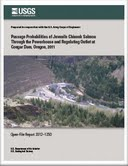Cougar Dam near Springfield, Oregon, is one of several federally owned and operated flood-control projects within the Willamette Valley of western Oregon that were determined by the National Oceanic and Atmospheric Administration’s National Marine Fisheries Service in 2008 to impact the long-term viability of several salmonid stocks. In response to this ruling, the U.S. Army Corps of Engineers is looking for means to reduce impacts to salmonids, including improving downstream passage of juvenile salmonids at Cougar Dam. This study of juvenile Chinook salmon (Oncorhynchus tshawytscha) passage at Cougar Dam was conducted to inform decisions about potential improvements for downstream fish passage. The primary objective of the study was to estimate route-specific passage probabilities of yearling Chinook salmon at Cougar Dam. The study was conducted using fish from a nearby hatchery surgically implanted with radio transmitters and passive integrated transponder (PIT) tags and released near the entrance of a temperature control tower through which all water going through the dam must pass. Water passing through the temperature control tower may be routed through a penstock to a powerhouse with two Francis turbines, or to a spillway-like structure called the regulating outlet. Secondary objectives of the study were to estimate the probability that fish enter a bypass at a non-federal facility downstream, and to estimate dam-passage and in-river fish survival. Dam operating conditions during the study included an average forebay elevation of 1,580 feet (National Geodetic Vertical Datum of 1929) and an average of 48.2 percent of the total dam discharge of 1,106 cubic feet per second passing through a regulating outlet opening of 1.25 feet. Dam passage probability was greatest at night (0.8741 standard error [SE] 0.0265) and primarily through the regulating outlet (0.8896 SE 0.0617 day; 0.9417 SE 0.0175 night). The joint probability of entering the bypass at Leaburg Dam and being detected at the PIT system within the bypass was 0.0755 (SE 0.0363), but some fish were known to pass the PIT system undetected, indicating that the true probability of entering the bypass was underestimated. The estimated survival of fish passing through the temperature control tower, through the dam, and to a site at a bridge over the South Fork of the McKenzie River 3.9 kilometers downstream was 0.3680 (SE 0.1322) for fish passing through the powerhouse, and 0.4247 (SE 0.0440) for fish passing through the regulating outlet. The estimated in-river survival through the 37.3 kilometers from the bridge to a site at Leaburg Hatchery on the McKenzie River was 0.5857 (SE 0.2227) for fish that had passed through the powerhouse, and 0.4537 (SE 0.0551) for fish that had passed through the regulating outlet.


